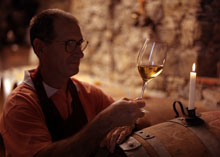






Trademarks classes
Trademarks may be filed in one or more of 45 classes of goods and services. Wine itself falls in class 33, while wine grapes (along with other fruit) fall in class 31. Given that confusion due to use of the same or similar mark may span more than one class though, registered marks are protected by section 34(1)(b) of the Trade Marks Act against use of a confusingly similar mark for either the identical or similar goods.
It is not permissible to file applications for one's mark across all classes, but rather only for goods and services for which the mark is used or intended to be used. The extension of protection to similar goods ensures that this rigid classification system cannot be used to side-step use of a similar mark on similar goods to those for which it is registered where confusion will be caused.
The applicant, Alexander Mettenheimer, owns the Zonquasdrift farm in the area between Malmesbury and Riebeek Kasteel - so named after the crossing point on the Berg River historically used by the Zonqua tribe.
Mettenheimer bought the farm in 2001 for its valuable 40-year-old Chenin Blanc vineyard, registered for single-vineyard production, along with its historic name. Mettenheimer was quick to recognise the value of Zonquasdrift as a trademark and secured his rights by filing an application for wines in class 33.
In 2008, one of the neighbouring farms to Zonquasdrift was purchased. It subsequently emerged that it was being run through the vehicle of a close corporation, Zonquasdrif Vineyards CC and was farming and selling wine grapes.
After an exchange of correspondence between Mettenheimer and the close corporation, it refused to change its name and the mark under which it traded. Mettenheimer therefore approached the court for an order that use of Zonquasdrif Vineyards for wine grapes infringed the Zonquasdrift registration for wine, and that the close corporation name was undesirable.
The question accordingly arose as to whether wine and grapes would be considered "similar" goods. The function of a trademark is to act as a "badge of origin" and announce to the public the source from which the goods emanate.
One would imagine that if Meerlust wine grapes or Fairview wine grapes were to be offered for sale, that the obvious assumption would be that these goods and the wine emanate from the same source.
This is particularly so in the wine and wine grape industry, where farms may produce and sell only grapes, or some grapes and some wine, or simply buy in grapes from which to make wine. Often, produce from various farms is combined, and the common thread, which the public know and trust, is the brand under which the resulting wine is sold.
However, Davis J found that confusion would not arise between Zonquasdrift wine and Zonquasdrif Vineyard grapes. He held that Zonquasdrift wine would not be assumed by the public to be produced from Zonquasdrif Vineyard grapes, and that the respective goods would not be confused.
It remains to be seen whether it shall be taken on appeal. For now though, all wine farms producing and selling grapes should take heed and apply for registered protection in class 31 for grapes themselves as well as class 33 for wine.